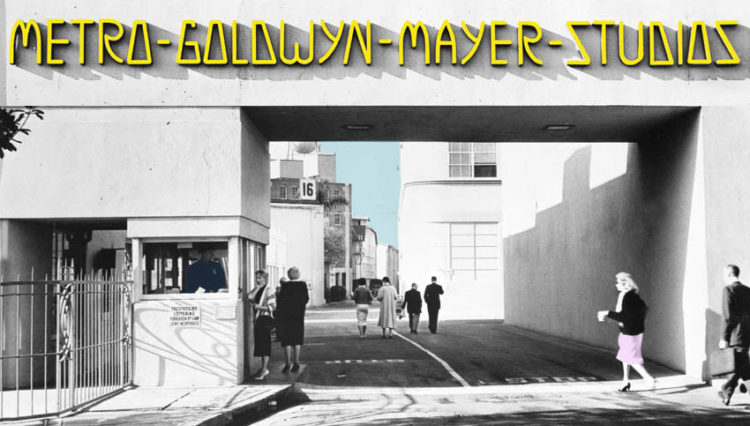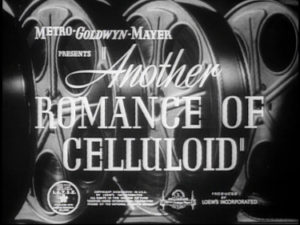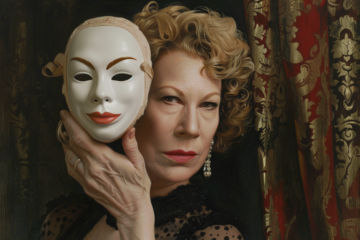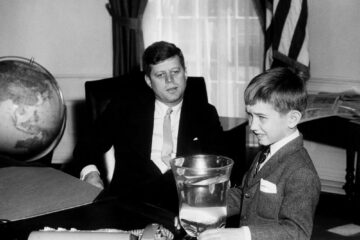MGM as Dream Factory
by Andrew Hamilton
TELEVISION, MOVIES, pop music, video games, the Internet, radio — the media of mass communications — are the chief mechanisms that determine “public opinion.” Entertainment programming is as important as slanted news coverage in the process.
Most of us are passive consumers of media throughout our lives. Entertainment programming simply “appears before” us.
In reality, of course, unseen people manage a massive physical and creative machinery generating the sights and sounds that stream unceasingly into billions of mesmerized brains globally, molding perceptions of reality and changing opinions and values.
Thus, a vast infrastructure surrounds the finished product. It is important to understand the race, ethnicity, religion, and ideological agenda of those who create it, and the business, legal, and government institutions necessary to sustain it.
For a century Hollywood has created, disseminated, and influenced entertainment programming around the world. During Hollywood’s “golden age” from 1925–1952, Metro-Goldwyn-Mayer (MGM) was the premier movie studio in the world.
Although the environment in which MGM and other historic studios flourished is gone, the company usefully illustrates the productive process — the Wizard behind the curtain.
MGM was formed in 1924 by Marcus Loew, a New York Jew who controlled an extensive chain of movie and vaudeville theaters, when he purchased and merged three California studios: Metro Pictures, Goldwyn Pictures, and Louis B. Mayer Pictures. The cost was $65 million ($875.3 million, or just short of $1 billion, today).
Although Louis B. Mayer (Lazar Meir, a Russian-born Jew) was placed in charge of production at the Culver City, California studio, the firm was owned and controlled throughout the period by Loew’s, Inc. of New York City. Mayer was a vice president of Loew’s, but not a shareholder.
After Marcus Loew’s death in 1927, control of the New York firm devolved to his right-hand man, Russian-born Jew Nicholas Schenck. He and L. B. Mayer, who disliked each other (Mayer irreverently referred to his superior as “Mr. Skunk” behind his back), jointly operated Hollywood’s most profitable studio for the next 30 years. (Nicholas’s brother Joseph Schenck was the powerful, longtime head of 20th Century Fox.)
At its peak, MGM employed 4,000 people and operated its own 100-man police force to maintain internal security. (An honest look at Hollywood security, organized crime, and corruption would be most enlightening.)
The studio released 50 movies a year under a rigorous shooting schedule and exacting budget.
Two 10-minute MGM shorts from 1939–40, part of the studio’s Romance of Celluloid series, as well as a look at the studio itself, provide insight into the physical and logistical infrastructure behind the motion picture business at that time.
From the Ends of the Earth: Another Romance of Celluloid (1939)
The narrator of From the Ends of the Earth enumerated some dazzling facts for theatergoers.
From “sunny France” rare perfumes arrived at the studio — “authentic bottles of the most luxurious scents” — for use on the beauty salon set of The Women.
In MGM’s wardrobe department, thousands of yards of imported cloth and laces were transformed by the scissors of expert cutters into the style creations of costume designer Adrian and his large corps of assistants.
Greta Garbo’s Ninotchka (1939) utilized hundreds of imported art objects from all over Europe.
From Africa and India elephants, baby elephants, lions, tigers, and chimpanzees were imported.
A 70-year-old automatic, piston-powered fan from Lahore, in the Punjab country of central India, driven by compressed air heated by a kerosene lamp, was used as a background prop in a scene from Lady of the Tropics (1939).
Fifteen years previously, in 1924, MGM had sent an enormous company to the shores of the Mediterranean to film Ben-Hur, starring homosexual Mexican actor Ramon Navarro and Francis X. Bushman. There the company made extensive purchases of antique Roman armor and implements of war: “No studio reproductions these, but genuine Roman relics centuries old.”
A partial list of materials used annually by MGM was provided:
- 9 million board feet of lumber from the forests of North America, enough to build a city of 1,500 homes.
- 900 tons of plaster.
- A quarter-million gallons of paint.
- 42,000 gallons of shellac.
- 110,000 pounds of rope, ranging from 1/4-inch sash cord to 6-inch hawser.
- A company switchboard with 2,400 extensions handled thousands of calls per day. Enough electricity, supplied by MGM’s own electrical plant, was used each year to light 25,000 homes.
- An onsite film laboratory processed 4.5 million feet of film per week, consuming 300,000 gallons of water per day drawn from the studio’s three artesian wells.
MGM’s stable of stars was legendary. From the Ends of the Earth concluded its preview of coming attractions with the familiar tagline: “Many happy hours of entertainment await you in this parade of HIT PICTURES from the studio with more stars than there are in the heavens!”
Despite a certain unevenness, including brief segments without sound, a 10-minute YouTube clip showing some of the screen tests for Gone With the Wind (1939) is instructive about acting, including the fierce competitiveness of the profession.
The man occasionally heard off-camera is Jewish homosexual George Cukor, originally assigned to direct the film. He was later replaced by Victor Fleming.
Thirty-two actresses tested for the part of Scarlett O’Hara, which eventually went to Vivien Leigh, including Tallulah Bankhead, Susan Hayward, Lana Turner, Joan Bennett, and Jean Arthur.
Paulette Goddard nearly landed the role, however. In a remarkable sequence Cukor tells her after she finishes her lines, “Your face is so hard, Paulette.” After lowering her head an instant, but otherwise not missing a beat and with the camera still rolling, Goddard’s face softens visibly and she repeats the lines. In another scene she switches rapidly back and forth between Scarlett O’Hara’s dialogue and Hattie McDaniel’s, doing both parts, the McDaniel lines in Negro dialect, but not mimicking McDaniel. (She also spoke Black dialect in certain scenes in 1943’s The Crystal Ball.)
A city within a city, MGM’s vast movie wonderland was closed to the public. It was carefully concealed from view on 6 fenced and gated lots totaling 185 acres.
Administrative headquarters was located in the Irving G. Thalberg Building on Lot 1, a white Art Deco structure graced with an early air-conditioning system. It had 235 offices for studio executives, producers, directors, writers, and legal and story departments. As many as 7,000 books, plays, and stories were read annually, and half a million story synopses kept on file.
The 44 acres of Lot 1 contained many of the studio’s 135 permanent buildings, including support offices, a commissary, barbershop, 28 sound stages, laboratories, photography studio, sound facilities, technical buildings, and specialized departments for cameras, lighting, special effects, miniatures, publicity, and fan mail. The Projection Department had 22 screening rooms.
The industrial center contained everything necessary for motion picture production: upholstery, carpenters’, machine, blacksmith, florists’, plaster, and plastic shops, a metal foundry, and a lumber mill.
Railroad spur lines delivered trainloads of lumber and other supplies on a regular basis.
The busy Research Department fact-checked scripts, costumes, and set designs.
MGM’s music department archived 4 million selections, making it the third largest music library in the world after the Library of Congress and the New York Public Library.
The Casting Office handled as many as 12,000 calls a day.
The Makeup Department processed up to 1,200 actors an hour or 12,000 a day.
Stored in the Property Department were more than 1 million props from every nation and historical period, including guns, clocks, full-size locomotives, row boats, and horse-drawn buggies.
The Art Department was responsible for creating the detailed, lavish exterior sets on the studio’s backlot, as well as “exterior” and interior sets for the many huge, soundproof, indoor sound stages.
An estimated 20 percent of all movies made in the United States were shot somewhere on the MGM backlot.
The permanent standing sets of locales from the four corners of the earth were used over and over, year after year, film after film. They were continuously altered, redressed, repainted and shot from multiple angles.
Many widely-seen movies and television shows were shot on sets that viewers never knew were located on a studio backlot. Facades were seen over and over again by the same audiences hundreds of times, yet uncritically perceived as Paris one week or Transylvania the next due to cleverly devised visual cues, painted backdrops, street signs, or establishing shots that deceived people again and again.
The 37-acre Lot 2 was situated across Overland Avenue from Lot 1. There was the Animation Department, where Tom and Jerry and other cartoons were drawn. William Hanna and Joseph Barbera got their start there.
Lot 2 also boasted the most-used section of the backlot, almost 10 acres re-creating six full-scale city blocks of New York and its boroughs, down to street signs, manhole covers, and fire escapes — detailed mock-ups of Park Avenue, Fifth Avenue, and streets known as East Side-West Side Street, Hester Street, Gullem Street, Church Street, Warehouse Alley, and Brownstone Street.
The famous Singin’ in the Rain (1952) scene featuring Irish American dancer Gene Kelly was shot on East Side Street in daylight, with heavy black tarps shutting out the California sun to simulate night and sprinkler heads supplying “rain.”
Lot 3, on 65 acres, also held many elaborate sets, including the Tarzan series’ “Jungle Island,” a 65-million gallon man-made lake, a tropical rainforest, rock formations, winding roads, a circus set, military bases, a POW camp, farms, and ranches.
There were three Western sets: “Western Street,” representing a prosperous town, “Billy the Kid Street,” a frontier village, and a deserted and faded “Ghost Town.”
Satellite Lots 4, 5, and 6 surrounded Lot 3. These contained the studio zoo mentioned previously with animal cages, a pen, and performance rings, thoroughbred horse stables, storage sheds for all modes of transportation, including fleets of aircraft and locomotives, and a nursery where plants, trees, shrubs, flowers, and even sod were grown for interior and exterior sets and the studio’s own landscaping needs.
One author observed,
I’ve always been haunted by and interested in Hollywood’s backlots in general. The idea that there exist places in the world where there are entire phantom towns constructed to mimic the real world — and yet where no one has ever lived, could ever live, is fascinating and mysterious and a little creepy. Backlots are supposed to duplicate our lives, our homes, and the city streets we move through every day, and yet although they can be as familiar to us as places we’ve lived in our actual lives, they remain unknowable, untouchable, just out of normalcy and of recognition.
Descriptions of MGM’s many contemporary and period sets in Culver City, long since leveled to make way for residential subdivisions, remind one strongly of a working version of Disneyland. Could Walt Disney have gotten his innovative idea for theme parks from MGM and other Hollywood studios? Disney’s parks resemble studio backlots far more than they do earlier amusement parks such as Coney Island.
 Hollywood: Style Center of the World: Another Romance of Celluloid (1940)
Hollywood: Style Center of the World: Another Romance of Celluloid (1940)
Another 10-minute MGM short, Hollywood: Style Center of the World: Another Romance of Celluloid (1940) provides some insight into the influence motion pictures exert over psychology and behavior.
The short opens with a miniature movie-within-a-movie: scenes of threshers harvesting wheat, pictures of fields, cattle, a barn, and a little Midwestern farmhouse where the story begins.
There a teenage farm girl receives a telephone call from her boyfriend inviting her to go on a date. She reminds her father that he promised to buy her a new dress, so they go to town to get one.
On Main Street the father and daughter spy a dress in a shop window. The display card next to a photo reads, “Joan Crawford in alluring new ensemble she wears in Susan and God.”
The narrator states,
And so, in this little town, far from the metropolitan influences, the Hollywood style reaches out to style and gown Mary just as smartly as Joan Crawford. Her ensemble was immediately responsible for Mary’s dress selection in the Susan mold. But why?
Simply because the motion picture has annihilated space, blotted out the backwoods, and banished what was once our custom to call “the country.” Today the girl from the country is just as modern, and dresses just as smartly, as her big city sister.
The film reveals that in Hollywood, “style center of the world,” celebrated designers create the film fashions that set the styles “for all the world to follow.”
Fashion scouts from the garment industry comb movie magazines for tips on ever-changing cinema fashions. Next, commercial designers re-create the latest Hollywood modes, and dress factories mass produce the new designs.
It is pointed out that MGM costume designer Adrian (Adrian Adolph Greenberg, a bisexual Jew married for 20 years to White actress Janet Gaynor), “Hollywood’s foremost studio designer,” had done more to influence style trends the world over than any other designer.
The Wardrobe Department on Lot 1, with 15 warehouses and 150,000 costumes from every historical period, outfitted as many as 5,000 actors and extras per day.
Referring to “New England Street,” the outdoor MGM set featured in the Andy Hardy series and other films, actor Mickey Rooney, the star of the series, observed many years later,
Creating this New England utopia was all part of L. B. Mayer’s master plan to reinvent America. In most of his movies that came under his control, Mr. Mayer knew that he was “confecting, not reflecting” America. He wanted values to be instilled in the country and knew how influential films could be. The picture helped Mr. Mayer cast a spell on America, on its values and attitudes and images.
This astute observation from an unlikely source is applicable to all Jewish media moguls past and present.
How successful they have been, and how unfortunate we have been, as a result.
* * *
Source: Author and Counter-Currents








why the word “homosexual” sprinkled throughout this “expose” on Hollywood “dream mill”/decadence??? . . . unless your’e appealing to the average troglodyte who’s never heard of ramon navarro or george cukor–let alone know they were gay–what’s the point??? (btw/who hasn’t heard of these people, or know they were gay???) to me it seems you raise a number of fine points & certainly man’s eyes are deluded by the disgusting swath of deceit that creeps out of the commerce-obsessed, USA “feel good” -cult of hollywood–but do you really think your essay is augured well by making gratuitous innuendo to people’s sexuality??? i’m pretty sure hollywood would be just as smarmy (& corny) a ‘dream factory’ were there no gays there or many gays there (in fact, it would probably be worse… Read more »
Many of my articles, including this one, are written with an underlying point of view, namely, the necessity of White survival, why a race and civilization are being destroyed, and the Jewish role in the process. Manipulation of sexuality on a mass scale is a key element of the System’s modus operandi, and homosexuality, now extended to “transgenderism,” has long been a major weapon of the enemy. The exact reasons for this and the mechanisms by which it occurs may be obscure, but Jews and the Left obviously find homosexuals useful to their project of social destruction. Moreover, widespread homosexuality in a culture–in our case fortified and advanced by Jews, the state, and other elite elements–is a tell-tale sign of collective death, like fungus on a tree. There are other… Read more »
Thank you for another fascinating expose of Jews and queers, and of that incredible MGM studio operation, Mr. Hamilton. I must be an average troglodyte because I didn’t know Cukor the Jew and Navarro the Mexican were queer (read: peculiar) until reading this, but could have guessed, knowing what I already know about Hollyweird. Some folks think homosexuality is just a dandy, harmless alternative lifestyle, but the National Alliance does not and has for decades had as its policy that members of “the third sex,” including bi-sexuals, are ineligible for membership in the organization. There are plenty of other organizations that welcome queers, transsexuals and the rest of that crowd, but our membership likes that NA does not. They also like that we do not allow race-mixers, Jews, and other… Read more »
We have to remember that young people are not ourselves, did not have our life experiences, and do not have our knowledge and memories. (Of course, in the case of this article there is the question of specialized knowledge as well, which is different. It is impossible to know everything.)
A woman my age told me she was talking to one of her young relatives recently and mentioned the movie Jaws (1975), released 42 years ago. The teen asked her what it was; she’d never heard of it.
I know who Cukor and his garbage “films” are
only because im fascinated by all aspects of
the complete takeover,by filthy Marxist Jews ,
of a former United States….that accelerated
and intensified since 1945.
Thats whats called or should be called every
young White male’s dream….
Course…its not.
But an older White man can hope.
Excellent answer to a somewhat convoluted
question…
Could it be more obvious how both Hollyweird
and Homosexuality are acutely effective
weapons concerning the complete destruction
of the spiritually healthy idea of The White
Family????
Tight work sir…and NV.
The homosexual is a jew concept . It is a “protagonist” throughout thier history . The subterfuge in Hollywood must amuse the groveling jew. Dream actors like Tab Hunter and others have been their nice, modest hero to promote the hypocrisy of the bourgeois American, CHristian ethic and always underlies the immoral motives of jew. ALso emasculation makes actors more compliant. Errol FLynn and Richard Boone and Mel Gibson are thorns in thier side , who sadly destroyed themselves from the unconscionable , salutary association with the jew . It is jew propaganda and is a pernicious industry . They manufacture the need for mostly young people to experience life through others vicariously because they are taught they have none of thier own. Randy Quaid is a later victim of… Read more »
I do not mind in the least that THEIR children become homosexual. In fact, it should be mandatory.